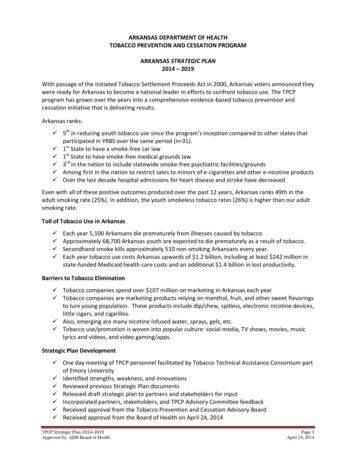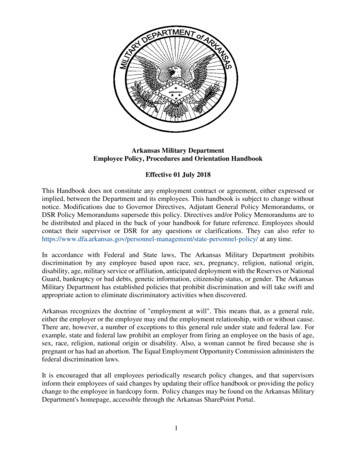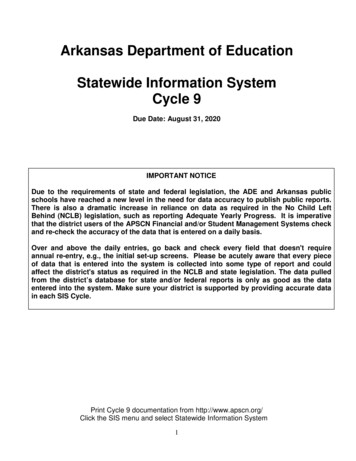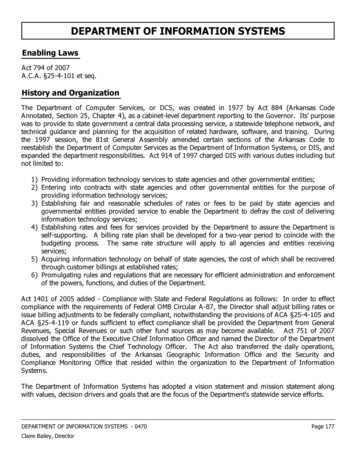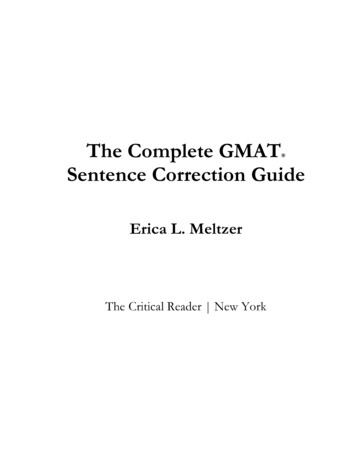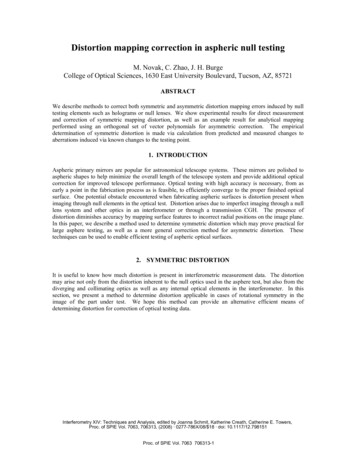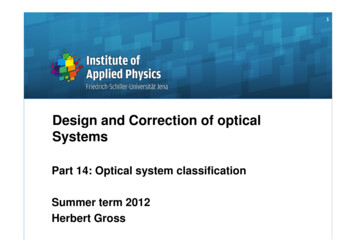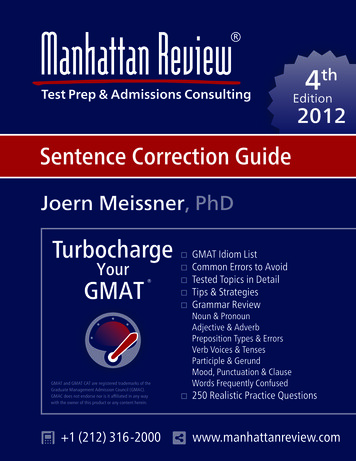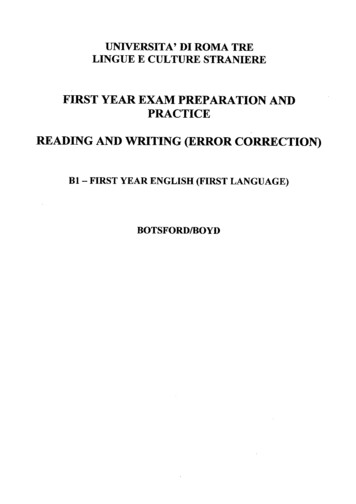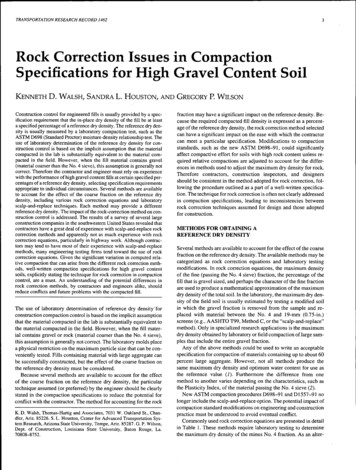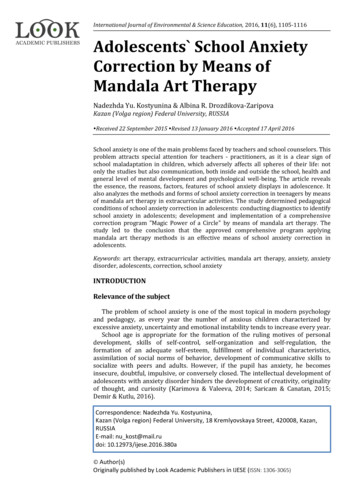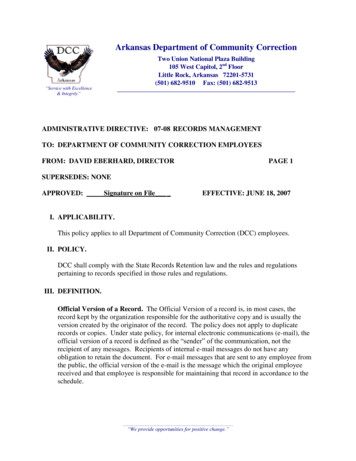
Transcription
Arkansas Department of Community CorrectionTwo Union National Plaza Building105 West Capitol, 2nd FloorLittle Rock, Arkansas 72201-5731(501) 682-9510 Fax: (501) 682-9513“Service with Excellence& Integrity”ADMINISTRATIVE DIRECTIVE: 07-08 RECORDS MANAGEMENTTO: DEPARTMENT OF COMMUNITY CORRECTION EMPLOYEESFROM: DAVID EBERHARD, DIRECTORPAGE 1SUPERSEDES: NONEAPPROVED:Signature on FileEFFECTIVE: JUNE 18, 2007I. APPLICABILITY.This policy applies to all Department of Community Correction (DCC) employees.II. POLICY.DCC shall comply with the State Records Retention law and the rules and regulationspertaining to records specified in those rules and regulations.III. DEFINITION.Official Version of a Record. The Official Version of a record is, in most cases, therecord kept by the organization responsible for the authoritative copy and is usually theversion created by the originator of the record. The policy does not apply to duplicaterecords or copies. Under state policy, for internal electronic communications (e-mail), theofficial version of a record is defined as the “sender” of the communication, not therecipient of any messages. Recipients of internal e-mail messages do not have anyobligation to retain the document. For e-mail messages that are sent to any employee fromthe public, the official version of the e-mail is the message which the original employeereceived and that employee is responsible for maintaining that record in accordance to theschedule.“We provide opportunities for positive change.”
IV. BACKGROUND.The Arkansas Records Retention Workgroup developed and maintains “The ArkansasGeneral Records Retention Schedule” to designate minimum retention requirements forrecords commonly found in state government. The schedule does not govern the retentionof records that are unique to individual agencies. Although an agency can supplement theschedule with agency-specific records, at this time the DCC has not done so. Records areorganized into seven categories: 1) General Administrative; 2) Meetings; 3) AutomatedSystems; 4) Personnel and Human Resources; 5) Fiscal; 6) Legal, and 7) Grants. The nameof a record category may or may not correspond to the area or section of an agency thathandles the record. This retention schedule addresses all record formats and media (i.e.electronic, paper, microfiche, etc.). The minimum retention requirement is determined bycontent, not by format or media (i.e., electronic, paper, microfiche). The agency does haveagency specific records that are not addressed by the Records Retention Schedule. In somesituations other policy guidance may address these “other records.” For example, there is apolicy governing “Offender Records.”V. RESPONSIBILITIES AND PROCEDURES.A. Parole/Probation Managers and Residential Center Supervisors must:1. Ensure staff complies with this policy.2. Appoint Records Custodian(s) who will be responsible for management of therecords within areas managed by the manager/supervisor.B. All employees must:1. Ensure the official version of a record (as defined) is retained as required by theRecords Retention Schedule (Attachment 2). This means maintaining the officialversion or, when the schedule calls for another office to maintain it, ensuring therecord is provided to the responsible office. This guidance applies to all officialversions of records addressed in the Records Retention Schedule, to include every“medium” (to include but not limited to paper, microfilm, hard/removable computerdisks, optical disks, and magnetic tapes).2. Manage their e-mail messages the same as they do for other records. This includesorganizing their e-mail messages so they can be located and used as may berequired; using the state retention law and DCC policy on retention to identify howlong e-mail messages must be kept; ensuring that e-mail messages are accessible forthe duration of applicable state or federal retention schedules, and; deleting e-mailmessages in accordance with the Record Retention Schedule and DCC policy.3. Cooperate with the designated Records Custodian or the office of primaryresponsibility to ensure documents are filed properly.2
C. Records Custodians must:1. On behalf of the manager/supervisor, monitor to ensure employees understand andcomply with this policy, providing assistance as necessary to facilitate compliance.2. Establish a filing system to facilitate organization, maintenance (according to therecords retention schedule) and disposition of records.3. Move files to an inactive/storage area as appropriate. Include a destruction date oneach storage box and/or inactive file.4. Destroy records governed by the Records Retention Schedule according to guidancein this policy.D. Destruction of Documents Addressed in the Records Retention Schedule.All documents addressed in the Records Retention Schedule must be destroyed at the endof their retention period unless the Director, Chief Deputy Director, Deputy Director orOffice of Primary Responsibility has specified in writing that a specified set ofdocuments must be kept longer. Documents containing sensitive information, such asbank account numbers, names of any person for any reason, offender identificationnumbers (PID) must be shredded on-site or through a contracted secured third-party.Documents that do not contain sensitive information may be recycled or discarded withregular trash.VI. ATTACHMENTS.Attachment 1. Suggestions for Organizing, Maintaining and Disposition of RecordsAttachment 2. Records Retention Schedule3
Attachment 1Suggestions for Organizing, Maintaining and Disposition of RecordsOrganize office files in a logical way.For filed items that are governed by the records retention schedule, mark the applicable GeneralSchedule (GS) number on the file folder label.When the GS specifies a number of years for retention, choose a “cut off” day of 30 June forfinancial records or 31 December for other records.On the “cut off” day, label the file folder as “inactive” put the full cut off date on the label (e.g., 31Dec 2007) and move the folder to an inactive storage area (such as another file drawer if you mayneed to access it again or a storage box). Ensure storage boxes are appropriately labeled. Thestorage box and folders must allow someone to quickly determine whether the records have beenkept the required amount of time, so the material can be properly disposed of in a timely manner.Make a new folder to replace the folder that was moved to the inactive storage area.Make a file plan such as the on1.N/ANoneFile Plan2.3.GS 01002GS 0400731 Dec31 DecComplaint RecordsEmployee Personnel Records4.GS 0500330 JunAccount ReconciliationExample file folder labels for Active record:LocationMain File Cabinet, Room 5 &Electronic Records (specify file path)Main File Cabinet, Room 5Supervisor’s Desk, Room 1 &Electronic Records (specify file path)Account’s Receivable Clerk’s File,Room 3Example file folder labels for Inactive record:Note: Use the Cut off “CY” (Calendar year) or “FY” (FiscalYear)1. File PlanNote, there is no need to keep a copy of anobsolete file plan.2. Complaint RecordsGS 010022. Complaint RecordsGS 01002Complaints Resolved in CY 2007Destroy After: 31 Dec 20103. Employee Personnel RecordsGS 040073. Employee Personnel RecordsGS 04007CY 2007Destroy After: (Look at GS 04007, minimumretention period column to determine date)
Suggestions for Organizing, Maintaining, and Disposition of Records (continued)For electronic records, you can create file folders and manage records in the same manner as isdone for paper records. Using the above file plan you would have the following electronic folders:Electronic File FoldersNotes0 To Be FiledEveryone should know where to file documentsthey handle routinely. When an employee does notknow where to file a document, they can place it inthis “to be filed” folder. If this is used,responsibility for reviewing documents promptlyand moving them to the proper folder belongs tothe Records Custodian unless a supervisor hasdelegated this to another employee.Keep the electronic copy of your file plan here!Item #2 on the file plan does not have an electronicfolder because you do not anticipate havingelectronic records for complaints.1 File Plan3 Employee Personnel Records4 Account ReconciliationAs with paper file folders, you can create additional electronic file folders in an “inactive” area foreach calendar year (or fiscal year) as appropriate. Rather than have excessively long file foldernames, you may want to include details about the applicable General Schedule number and“Destroy After ” date in a “Read Me for Disposition Instructions” document in the folder.
Attachment 2Records Retention ScheduleTable of ContentsGeneral Schedule (GS) 01 General Administrative RecordsGeneral Schedule (GS) 02 Meeting RecordsGeneral Schedule (GS) 03 Automated System RecordsGeneral Schedule (GS) 04 Personnel and Human Resource RecordsGeneral Schedule (GS) 05 Fiscal RecordsGeneral Schedule (GS) 06 Legal RecordsGeneral Schedule (GS) 07 Grant Records
General Schedule (GS) 01 General Administrative RecordsThis category includes records regarding agency policies, activities and actions, including informationreleases, public information, office files, and requests for information.Category andRecord NumberDescriptionMinimumPeriodGS 01001Agency Directives,Internal Policies andProceduresManuals, general guidelines, orsimilar records distributedinternally for the use of employeesthat sets out agency policies andprocedures and do not affect theprivate rights or proceduresavailable to the publicUntil superseded plus 3yearsAny agency record that officiallyinitiates, rescinds, or amendsinternal policies or procedures thatare applicable to Arkansasagencies, boards, commissions.Formal complaint documentsreceived by the agency from thepublic concerning generaloperations of the agency or itsemployees, and records pertainingto the resolution of the complainEach Deputy Director isresponsible for ensuring theofficial version of all guidelines,manuals or other policydirectives issued by them as adirective to their staff ismaintained. The Chief DeputyDirector is responsible forensuring agency wide policiesand procedures adhere to thispolicy.3 years after the finalRecipients of complaints areresponsible for maintaining allrecords regarding a complaintunless the complaint isforwarded through the chain ofsupervision or it becomes theresponsibility of legal counsel.Communication that hassignificant administrative valueand pertains to the implementationor modification of the agency’sadministrative operations, rules, orpolicies and procedures that governthe agency.4 yearsThis records categoryshould be used only forcorrespondence that is notincluded in or directlyrelated to another recordsseries in this scheduleGS 01002Complaint RecordsGS 01003Correspondence –SubstantiveExamples include but are notlimited to the following:- Correspondence record thatannounces reports, decisions, orrecommendations implementedin agency business- Correspondence that is essentialto supporting a final decisionrelated to the formulation,implementation or modificationof an agency’s administrativeoperations, rules, procedures, orpolicies- Executive-level correspondencerecord regarding state agencypolicies and proceduresExecutive-level correspondencerecord announcing a new internalpolicy to agency staffRetention Office of PrimaryResponsible and Notesdisposition of the complaintIf a complaint becomes thesubject of litigation, whichinvolves the agency receivingthe complaint, it must beincluded in and is subject tothe minimum retention periodof a litigation record - Refer toGS 06006 within this scheduleNote: Retention of E-mailcorrespondence is decided bythe CONTENT not the mediumof the record.All employees are responsiblefor determining if the content ofa communication is substantiveor non-substantive in nature.Substantive communicationsmust be maintained by theemployee who generates orreceives the communicationfrom outside sources.Note: An attachment orenclosure within acorrespondence record shouldbe evaluated separately for itsrespective retention period.
Category andRecord NumberDescriptionMinimumPeriodGS 01004Correspondence –Non-SubstantiveCommunication that conveysinformation of temporary businessimportance or unremarkablecommunication concerning dayto-day office administration andactivities.Record may be destroyedafter it has served itsintended purpose or is nolonger of administrativevalue to the agencyExamples include but are notlimited to the following:Retention Office of PrimaryResponsible and NotesNote: Retention of E-mailcorrespondence is decided bythe CONTENT not the mediumof the record.- Correspondence that includesinformation not attempting toinfluence policy- An e-mail message sent to a largenumber of people, at the same timevia an e-mail distribution listsoftware application (i.e. listservmessage).- Agency event noticeso A correspondence recordnotifying employees of anupcoming meeting wouldonly have value until themeeting has been attended orthe employee receiving themessage has marked the dateand time in his/her calendar- Routine requests for publicationsrecordsIncoming letters or memoranda oftransmittal that add nothing ofsubstance to enclosuresAll employees are responsiblefor determining if the content ofa communication is substantiveor non-substantive in nature.Substantive communicationsmust be maintained by theemployee who generates orreceives the communicationfrom outside sources.Note: An attachment orenclosure within acorrespondence record shouldbe evaluated separately for itsrespective retention periodGS 01005News or PressReleasesNews or press release issued by theagency1 YearThe Public Relations Officer isresponsible for maintaining anypress releases issued by theagency or requests forinformation.GS 01006Publications, StateA record that is produced by theauthority of or at the total or partialexpense of the agency or isrequired to be distributed underlaw by the agency and is publiclydistributed. One copy of each statepublication as defined aboveexcept a publication that is subjectto a different retention period inthis schedule. For example,information pamphlets or booklets.- Until the release of thenext part in a series (i.e.serial publications issuedin successive partsbearing numerical orchronologicaldesignations).Copies of state publications mustbe submitted to the ArkansasState Library for document typesand exemptions.- If the publication is not partof a series: Until it hasserved its intended purpose.- Consistent with ArkansasCode Annotated: § 13-2201The Public Relations Officer isresponsible for maintaining anofficial version of anypublication released by theagency. The Public RelationsOfficer is responsible forensuring all publications aresubmitted to the Arkansas StateLibrary
Category andRecord NumberDescriptionMinimumPeriodGS 01007PresentationsFormal presentations delivered by 1 yearthe agencyRetention Office of PrimaryResponsible and NotesAgency personnel who makes aformal presentation regardingDCC operations to any group isresponsible for ensuring that acopy of that presentation and allmaterials distributed at thepresentation, including a copy ofany PowerPoint or other mediapresentation, is maintainedaccording to the schedule.Presentations by agency anpersonnel who are acting assubject matter experts and whosepresentation is not agency specificbut is general in nature are notincluded under this policy.GS 01008Papers and ReportsPapers or reports as published by the 4 yearsagencyThe Public Relations Officer isresponsible for maintaining anofficial version of any publicationreleased by the agency. ThePublic Relations Officer isresponsible for ensuring allpublications are submitted to theArkansas State Library. TheDCC Research & EvaluationSection will keep Annual Reportsfor the in-house libraryindefinitely but no less than therequired time frame.GS 01009Training MaterialsInstructional materials developed1 year after updated or after itby, or for, the agency for traininghas served its intendedentities or individuals it regulates or purposeservesGS 01010Strategic PlansAgency/division strategic planswhich would also include, but notbe limited to, DisasterPreparedness/Recovery Plans,Business Continuity Plans, andInformation Technology PlansOriginators of these materialsmust provide the material to theJAKE Coordinator for archivingand appropriate disposition. TheHuman Resources Section isresponsible for archiving JAKEtraining records when anemployee leaves the agency andfor final disposition.[Also see GS 01007 and GS04002]The Chief Deputy Director isresponsible for maintaining anofficial version of the agencystrategic plans developed by theagency.Until plan is replaced by anupdated version plus 1 year.General Schedule (GS) 02 Meeting RecordsThis schedule does not pertain to any DCC records.(Rev 4/30/2013)
General Schedule (GS) 03 Automated System RecordsAutomated System Records include those that are generated or produced in support of the agency’sinformation system operations.Category andDescriptionMinimumOffice of PrimaryRecord NumberRetention PeriodResponsible and NotesGS 03001Data or DatabaseDictionaryDocumentationGS 03002Network Design FilesGS 03003Network and SystemUsage FilesGS 03004Support ServicesFiles - HardwareGS 03005Systems andApplicationsDevelopment RecordsDatabase and data file documentation,including, but not limited to, datadictionaries, metadata documentation,data element reports, diagram of logicaldata model, and any other database ordata file documentation that could beused for reference material.Records that describe the agencies’local and wide area networkschematics, including, but not limitedto, records containing networktopology, circuit descriptions, types ofnetwork connections, cable ID map,and other relevant network designinformationRecords created to monitor the use ofthe agency's network traffic and systemaccess by its customers or employees System usage files would include,but not be limited to, user accountlog records and accessauthorization log files Network usage files wouldinclude, but not be limited to, login records, security logs, routerlogs and firewall logsRecords documenting support servicesprovided to specific data processingequipment or installations, includingsite visit reports, program andequipment service reports, servicehistories, and related correspondenceand memosRecords created and used to develop,redesign or modify an automatedsoftware system or application,including user requirements, statusreports, correspondence, and highproductivity tool logic constructs usedto generate such components as reports,queries, forms, and macros; user andoperational documentation describingsystem operations, including systemdocumentation records, user guides,system diagrams, and input/outputspecificationsUntil record is replacedby an updated versionUntil record is replacedby an updated versionAs long asadministrativelyvaluable to the agencyAs long asadministrativelyvaluable to the agencyProduction copies untilno longer useful fortracking systemchanges or untiltransfer of system datato a new operatingenvironmentThe IT Administrator isresponsible for ensuring that theInformation Technology Sectionmaintains all requireddocumentation as detailed in thissection of the schedule.
Category andRecord NumberDescriptionMinimumRetention PeriodOffice of PrimaryResponsible and NotesGS 03006System and DatabaseBackup FilesRecords needed to restore a system andits data in the event of system or datalossThe IT Administrator isresponsible for ensuring that theInformation Technology Sectionmaintains all requireddocumentation as detailed in thissection of the schedule.GS 03007System SecurityAccess FilesRecords created to document users’access rights and privileges to datarepositories or granting authorization tosyste
Jun 18, 2007 · The Arkansas Records Retention Workgroup developed and maintains “The Arkansas . 2. Appoint Records Custodian(s) who will be responsible for management of the records within areas managed by the manager/supervisor. B. All employees must: 1. Ensure the official versio

